Accepted Scientific Name: Thelocactus hexaedrophorus (Lem.) Britton & Rose
Bull. Torrey Bot. Club 1922, xlix. 251
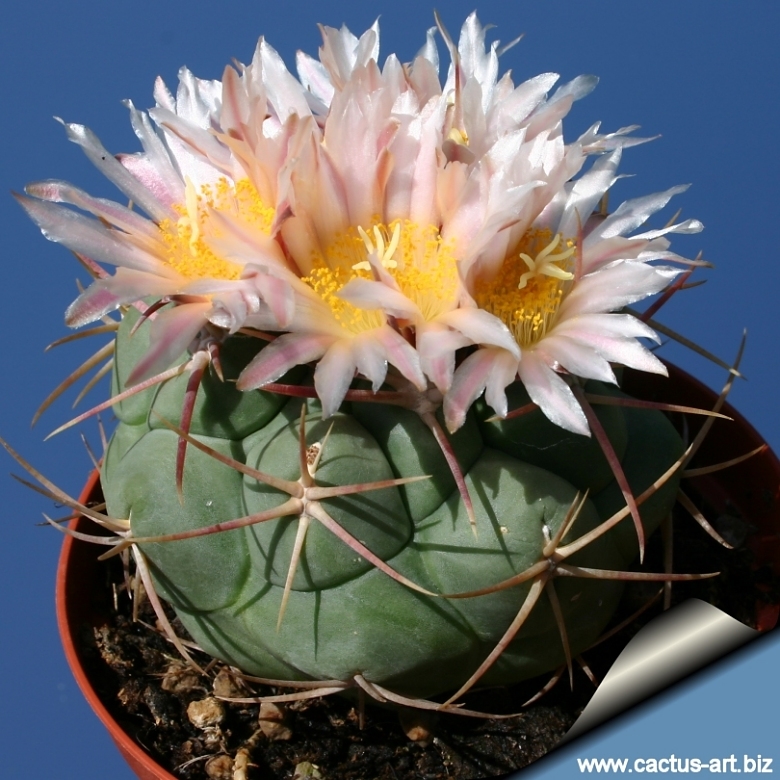
Echinocactus hexaedrophorus (Thelocactus hexaedrophorus) Photo by: Cactus Art
Origin and Habitat: San Luis Potosi, Zacatecas, Tamaulipas, and Nuevo Leon, Mexico.
Altitude: Subspecies hexaedrophorus grows a lover altitude from 1100 to 2000 metres above sea level. (Subspecies lloydii 2200-2300).
Habitat: It grows in large numbers on gentle limestone hill slopes, plains and terraces in the Chihuahuan Desert, savanna, and grasslands, often in association with other plant species, including Mammillaria parkinsoniiSN|2309]]SN|20725]], Mammillaria aureilanataSN|20725]]SN|2309]], Ariocarpus retususSN|2079]]SN|2079]], Gymnocactus knuthianusSN|12746]]SN|12746]], Coryphantha maiz-tablasensisSN|3914]]SN|10267]], Astrophytum myriostigmaSN|1845]]SN|1845]], Echinocactus platyacanthusSN|10367]]SN|10367]] and Echinocereus blanckiiSN|7775]]SN|7478]], Coryphantha radiansSN|10267]]SN|3914]], Ferocactus latispinusSN|4259]]SN|4259]], Echinocereus pectinatusSN|8503]]SN|8503]], Echinocereus cinerascensSN|7478]]SN|7775]], Opuntia rastreraSN|8157]]SN|19989]], Opuntia lindheimeriSN|19931]]SN|19931]], Opuntia imbricataSN|19989]]SN|8157]], Myrtillocactus geometrizansSN|8050]]SN|8050]], Heliabravoa chendeSN|7732]]SN|7732]], Agave salmianaSN|27883]]SN|27883]], Yucca filifera, Jatropha spathulata and Fritillaria lanceolata.
Synonyms:
See all synonyms of Thelocactus hexaedrophorus
Description: Thelocactus hexaedrophorusSN|10830]]SN|10830]] is a solitary and quite variable cactus with flattened stems. Many local forms are known, often formally described, that differ in stem, spine or flower morphology. Because of the large variability of the species in the whole distribution area, none of these are recognised today.
Stem:Globose or somewhat flattened above or umbilicate, glaucous, olive-green, or greyish-green eventually tinged in pink or purple, 3-7,5 cm tall , 8-15(-20) in diameter (eventually grows a little taller in cultivation), strongly tubercled and not ribbed.
Ribs: 8-13 indistinct, but generally evident in adult plants.
Tubercles: Fat, prominent, polygonal-rounded (hexagonal or pentagonal based), arranged in indefinite spirals, not flattened laterally, sometime compressed at the tip, 8-20 mm long, 13-27 mm large.
Areoles: 4-13 mm long, 12-28 mm apart, on top of the tubercles, elongated into a short groove, without nectar secreting glands.
Spines: Usually strong and variable in length depending on the clone often difficult to distinguish as centrals and radials.
Radial spines: 4-6 (6-8 on subsp. lloydii), erect to spreading, unequal, (5-)11-18(-60) mm long, pure white, ochre, reddish to brown, rigid, straight or curved, acicular to subulate and annulate.
Central spines: Almost always absent or sometime 1(-3), erect, much stouter than the radials, 15-18(-30) mm long, ochre, pinkish-grey, reddish, purplish, brow to whitish acicular to subulate.
Flowers: Silvery-white or rarely pinkish with more or less magenta midribs, 4,5-5,5(-10) in diameter, broader than long when expanded . Tube very short. Pericarpel covered with scales. Perianth-segments oblong, purplish; stigma-lobes yellowish white.
Fruit: Spherical, with scales, green magenta, 7-12 mm becoming dry at maturity dehiscing by basal pores.
Seeds: 1,5-2 mm long and 1,2-1,5 broad, with testa reticulate, divided into polygonal or square areas.
Subspecies, varieties, forms and cultivars of plants belonging to the Thelocactus exaedrophorus group
 Thelocactus hexaedrophorus (Lem.) Britton & Rose: (subsp. hexaedrophorus) has hemispheric tubercles, 0-1 reddish central spine, 4-6 reddish radials, and flowers 4-5.5 cm Ø. Distribution: widespread in San Luis Potosi, Tamaulipas, and Nuevo Leon.
Thelocactus hexaedrophorus (Lem.) Britton & Rose: (subsp. hexaedrophorus) has hemispheric tubercles, 0-1 reddish central spine, 4-6 reddish radials, and flowers 4-5.5 cm Ø. Distribution: widespread in San Luis Potosi, Tamaulipas, and Nuevo Leon. Thelocactus hexaedrophorus var. droegeanus (Hildm. ex K.Schum.) Pilbeam: has ash-grey compressed, closely packaged tubercles, shorter spines and small flowers. Distribution: La Bonita, south of Matehulla in San Luis Potosi.
Thelocactus hexaedrophorus var. droegeanus (Hildm. ex K.Schum.) Pilbeam: has ash-grey compressed, closely packaged tubercles, shorter spines and small flowers. Distribution: La Bonita, south of Matehulla in San Luis Potosi. Thelocactus hexaedrophorus var. fossulatus (Scheidw.) Backeb.: Usually solitary, clustering only after many years, from the base It has 1 red central spine and 4-6 reddish-gray-white radial spines per areole They are thick, long and sharp.
Thelocactus hexaedrophorus var. fossulatus (Scheidw.) Backeb.: Usually solitary, clustering only after many years, from the base It has 1 red central spine and 4-6 reddish-gray-white radial spines per areole They are thick, long and sharp. Thelocactus hexaedrophorus var. fossulatus cv. Long spines (Japan) (Scheidw.) Backeb.: Selected cultivar immediately distinguished from the other Thelocacti of this grou for the very strong, long and colourful spines.
Thelocactus hexaedrophorus var. fossulatus cv. Long spines (Japan) (Scheidw.) Backeb.: Selected cultivar immediately distinguished from the other Thelocacti of this grou for the very strong, long and colourful spines. Thelocactus hexaedrophorus subs. kvetae Chvastek & Halda: has flattened discoidal bodies, bright purple-pink coloured flowers and larger seeds. Distribution: Central Mexico, San Luis Potosi [near Rio Verde].
Thelocactus hexaedrophorus subs. kvetae Chvastek & Halda: has flattened discoidal bodies, bright purple-pink coloured flowers and larger seeds. Distribution: Central Mexico, San Luis Potosi [near Rio Verde]. Thelocactus hexaedrophorus var. labouretianus (K.Schum.) Pilbeam: grey stems, white pink flowers, and nice spination. At first the plants have larger tubercles that may become closely packaged as the plant gets older.
Thelocactus hexaedrophorus var. labouretianus (K.Schum.) Pilbeam: grey stems, white pink flowers, and nice spination. At first the plants have larger tubercles that may become closely packaged as the plant gets older. Thelocactus hexaedrophorus subs. lloydii (Britton & Rose) N.P.Taylor: has delta-shaped tubercles, 1-3 reddish central spines, 6-8 reddish white to brownish radials, and flowers 3,3-3,6 cm Ø. Distribution: Zacatecas.
Thelocactus hexaedrophorus subs. lloydii (Britton & Rose) N.P.Taylor: has delta-shaped tubercles, 1-3 reddish central spines, 6-8 reddish white to brownish radials, and flowers 3,3-3,6 cm Ø. Distribution: Zacatecas. Thelocactus hexaedrophorus subs. lloydii f. major: has very long ( up to 8 cm long) central spines, more numerous (6-8) radials, and pure white flower. Distribution: San Luis Potosí and Nuevo Leon.
Thelocactus hexaedrophorus subs. lloydii f. major: has very long ( up to 8 cm long) central spines, more numerous (6-8) radials, and pure white flower. Distribution: San Luis Potosí and Nuevo Leon. Thelocactus hexaedrophorus subs. lloydii cv. monstruosus: has firm, rubbery-textured glaucous green stems, the surface is naked or with few scattered spine clustes.
Thelocactus hexaedrophorus subs. lloydii cv. monstruosus: has firm, rubbery-textured glaucous green stems, the surface is naked or with few scattered spine clustes. Thelocactus hexaedrophorus var. paradensis Pilbeam: It is a white flowering form of Thelocactus hexaedrophorus subs. lloydii. It is known in cultivation only.
Thelocactus hexaedrophorus var. paradensis Pilbeam: It is a white flowering form of Thelocactus hexaedrophorus subs. lloydii. It is known in cultivation only.
Notes: Thelocactus hexaedrophorusSN|10830]]SN|10830]] is an example of hexagonal configurations of stem-segments surface, other plant that show hexagonal tubercles comprises Matucana krahniiSN|6031]]SN|6031]] and Tephrocactus geometricusSN|14349]]SN|14349]].
Bibliography: Majoer references and further lectures
1) N. L. Britton, J. N. Rose “The Cactaceae. Descriptions and Illustrations of Plants of the Cactus Family.” Volume 4, The Carnegie Institution of Washington, Washington 1923
2) Edward Anderson “The Cactus family” Timber Press, Incorporated, 2001
3) James Cullen, Sabina G. Knees, H. Suzanne Cubey "The European Garden Flora Flowering Plants: A Manual for the Identification of Plants Cultivated in Europe, Both Out-of-Doors and Under Glass" Cambridge University Press, 11/Aug/2011
4) David R Hunt; Nigel P Taylor; Graham Charles; International Cactaceae Systematics Group. "The New Cactus Lexicon" dh books, 2006
5) Clive Innes, Charles Glass “Cacti” Portland House, 01/May/1991
6) Hisho Hirao “Colour Encyclopaedia of Cacti” Seibundo Shinkosha Pub. Co., Ltd 1976
7) E Haustein “Der Kosmos Kakteenfuehrer” Balogh Scientific Books, United States, 01/Dec/1998
8) Willy Cullmann, Erich Götz (Dozent Dr.), Gerhard Gröner “The encyclopedia of cacti” Timber Press, 1987
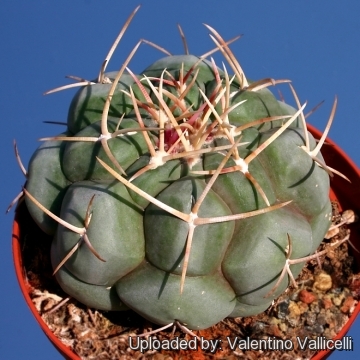 - is a roundly flat and glaucous-grey cactus, It has the best tubercles of an any of the Thelocactus, and is a must for any collection. (Thelocactus hexaedrophorus) Photo by: Valentino Vallicelli
- is a roundly flat and glaucous-grey cactus, It has the best tubercles of an any of the Thelocactus, and is a must for any collection. (Thelocactus hexaedrophorus) Photo by: Valentino Vallicelli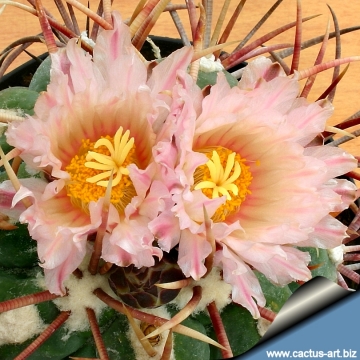 Echinocactus hexaedrophorus (Thelocactus hexaedrophorus) Photo by: Cactus Art
Echinocactus hexaedrophorus (Thelocactus hexaedrophorus) Photo by: Cactus Art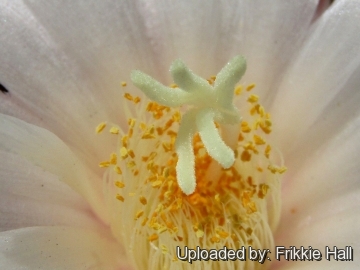 Echinocactus hexaedrophorus (Thelocactus hexaedrophorus) Photo by: Frikkie Hall
Echinocactus hexaedrophorus (Thelocactus hexaedrophorus) Photo by: Frikkie Hall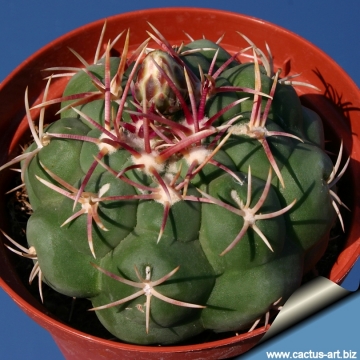 Echinocactus hexaedrophorus (Thelocactus hexaedrophorus) Photo by: Cactus Art
Echinocactus hexaedrophorus (Thelocactus hexaedrophorus) Photo by: Cactus Art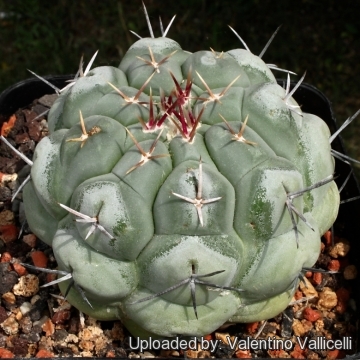 Echinocactus hexaedrophorus (Thelocactus hexaedrophorus) Photo by: Valentino Vallicelli
Echinocactus hexaedrophorus (Thelocactus hexaedrophorus) Photo by: Valentino Vallicelli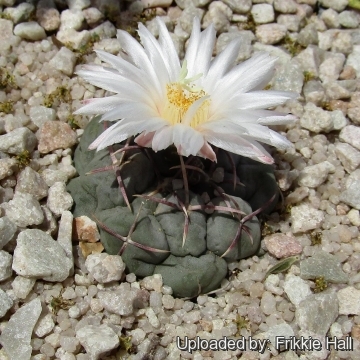 Echinocactus hexaedrophorus (Thelocactus hexaedrophorus) Photo by: Frikkie Hall
Echinocactus hexaedrophorus (Thelocactus hexaedrophorus) Photo by: Frikkie HallCultivation and Propagation: This cactus is easy to cultivate and recommended for any collection that needs lots of light with ample airflow.
Growth rate: It is a small growing, but easily flowering species. It offset from the base and can fill a 25 cm pot in just a few years given the best conditions.
Soils: It likes very porous standard cactus mix soil with little organic matter (peat, humus).
Repotting: Repotting every 2-3 years. It will need a pot with sufficient depth to allow the tap root. As it is especially prone to rot under-pot in a smaller container filled with very porous compost. Use pot with good drainage.
Watering: Water regularly in summer, but do not overwater (very wet-sensitively, especially in light of its succulent root system). Its roots are easily lost in pots that stay damp for any length of time. Keep dry with ample airflow in winter. In the rest period no high atmospheric humidity!! Care must be taken with watering as they tends to become swollen and untidy in growth habit if given too much water and shade.
Fertilization: During the growing season enrich the soil using a fertilizer rich in potassium and phosphorous, but poor in nitrogen, because this chemical element doesn’t help the development of succulent plants, making them too soft and full of water.
Hardiness: Reputedly sensitive to frost , but less so if kept on the dry side prior to, and during, cold weather (hardy to -7° C for short periods). However some warmth throughout the year will increase the grower's success (minimum 5° to 8°C during rest season).
Exposition: Outside bright sun, filtered sunlight or afternoon shade, inside it needs bright light, and some direct sun. Subject to sunburn if exposed to direct sun for too long. Tends to bronze in strong light, which encourages flowering and heavy wool and spine production.
Uses: It is an excellent plant for container growing. It always looks good and stays small. It look fine in a cold greenhouse and frame.
Pests & diseases: It may be attractive to a variety of insects, but plants in good condition should be nearly pest-free, particularly if they are grown in a mineral potting-mix, with good exposure and ventilation. Nonetheless, there are several pests to watch for:
- Red spiders: Sensitive to red spider mite. Overhead watering is helpful in controlling mites.
- Mealy bugs: Occasionally mealy bugs they develop aerial into the new growth among the wool with disfiguring results, but the worst types develop underground on the roots and are invisible except by their effects.
- Scales: Scales are rarely a problem.
- Rot: Rot it is only a minor problem with cacti if the plants are watered and “aired” correctly. If they are not, fungicides won't help all that much.
Reproduction: Nearly always from seed, since the plant rarely produces plantlets.
















